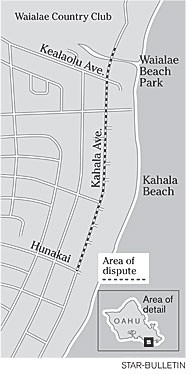JAMM AQUINO / JAQUINO@STARBULLETIN.COM
Dense shrubbery and vegetation encroach onto Kahala Beach in this photo taken May 24. The state Land Department has sent letters to 12 Kahala homeowners to trim back their vegetation because of blocked access to the beach.
|
|
Plant growth blocks Kahala beach access
Property owners get 30 days to cut back excess vegetation to comply with laws
STORY SUMMARY »
The state has sent letters to 12 Kahala beachfront property owners whose vegetation is forcing people to walk in the water when going from one end of the beach to the other.
It's the first time the state has used a "global approach" by contacting several owners in an area to solve the problem of vegetative encroachment, said Sam Lemmo, administrator of the Office of Conservation and Coastal Lands.
"Today most people wouldn't go to the beach without looking at the tide chart," said Lucinda Pyles, vice chairwoman of the Waialae-Kahala Neighborhood Board. "I just hope that people will try to voluntarily work together to preserve something that's important to the public."
FULL STORY »
Walking along Hawaii's beaches, particularly in Kahala, is getting tougher.
Twelve Kahala property owners received letters from the state last month because plant growth fronting the ocean is forcing people to wade into the water while walking from one end of the beach to the other.
 It's the first time the state has sent letters to several residents of the same area over vegetation that interferes with beach access along the shore, said Sam Lemmo, administrator of the Office of Conservation and Coastal Lands.
It's the first time the state has sent letters to several residents of the same area over vegetation that interferes with beach access along the shore, said Sam Lemmo, administrator of the Office of Conservation and Coastal Lands.
The problem is not just limited to Kahala, Lemmo said. Encroachment is also happening in Kailua and the North Shore on Oahu, Kihei on Maui, and the North Shore on Kauai, he added.
"We've had problems with shoreline owners on virtually every stretch of the Hawaiian shoreline," Lemmo said.
Along Kahala Beach, the state took a "global approach" to the vegetation problem, hoping to resolve complaints at once, rather than piece by piece, Lemmo said.
While the state is hoping for cooperation, the vegetation issue is pitting residents against each other.
Stanton Johnston, who received a letter from the state, said the naupaka on his property holds the land in place, protecting it from erosion.
"I'm not going to cut it because then if my house does flood it's my fault," he said. "It's like taking down the seawall. It would be foolish. My intention is leave it, let it go."
While agreeing that some vegetation along the beach is overgrown, he said the state should look at the properties individually, rather than demand everyone comply.
Lucinda Pyles, a Kahala resident for more than three decades, said the overgrowth forces older people and small children into waist-deep water, a potential hazard.
"People who may have only been coming to the beach for a few years, they just think that's the way it's always been," Pyles, vice chairwoman of the Waialae-Kahala Neighborhood Board, said. "They don't know what they've lost."
She continued, "I just hope that people will try to voluntarily work together to preserve something that's important to the public."
JAMM AQUINO / JAQUINO@STARBULLETIN.COM
Dense shrubbery and vegetation along Kahala beachfront property is forcing beach-goers to wade into the water at several points to get from one end of the beach to the other. In response, the state sent 12 homeowners letters asking them to trim back the plant growth.
|
|
Lemmo said the state sent the letters in response to "tremendous pressure" from area residents, including the Waialae-Kahala Neighborhood Board, to tackle the problem. Some of the vegetation, mainly naupaka and some hau, grows about 15 feet below the shoreline, he said.
On May 7 state investigators mailed letters and pictures of the vegetation to property owners, asking them to trim the plant growth.
According to state law, the beach makai of the shoreline -- set annually by the high water mark during high tide in the season with the highest surf -- is reserved for public access. Impeding passage below the shoreline is punishable by up to a $2,000 fine.
While the plants might be illegal, the state will not cut the vegetation in Kahala because it might be on private property, said Dolan Eversole, a University of Hawaii coastal geologist working as a technical adviser for the state.
In some cases, erosion has removed so much land that the private property is actually underwater, Eversole said.
The state hasn't gone through the lengthy process to investigate the property line, but even if the vegetation is on private property, state law requires public access beneath the shoreline, Eversole said.
"There's no such thing as a private beach in Hawaii," Eversole said.
The state is more concerned about beach access than property lines and is only trying to address the most egregious violations, Eversole said.
Beach-goers recently had mixed emotions about the plant growth along the beach.
Jessie Shimamoto recalled carrying her belongings through the water to circumnavigate the vegetation. But with the serenity of the beach, the vegetation didn't bother her too much.
"It's kind of one of the things you deal with," she said.
Don Blakeley, another beach visitor, said he enjoyed the shade from the vegetation, which he said added to the scenery.
In the letters sent to residents, the Department of Land and Natural Resources asked the property owners to remove encroaching vegetation and to call the state within 30 days.
Lemmo said the response has been mixed; at least one property owner cut back the plants. Lemmo declined to say whether there would be consequences if the owners do not comply.

